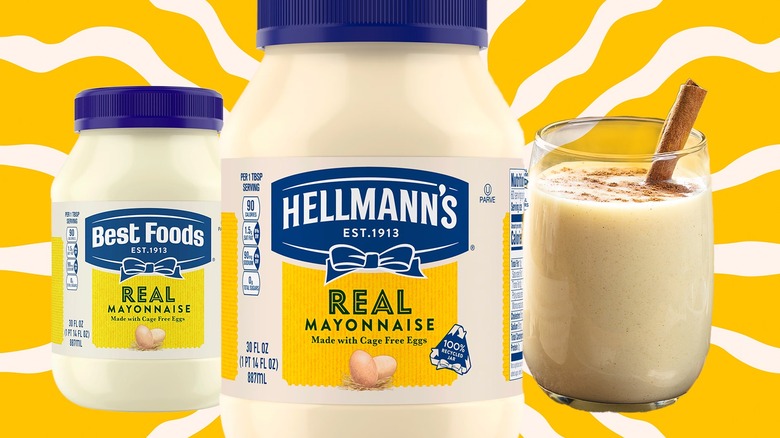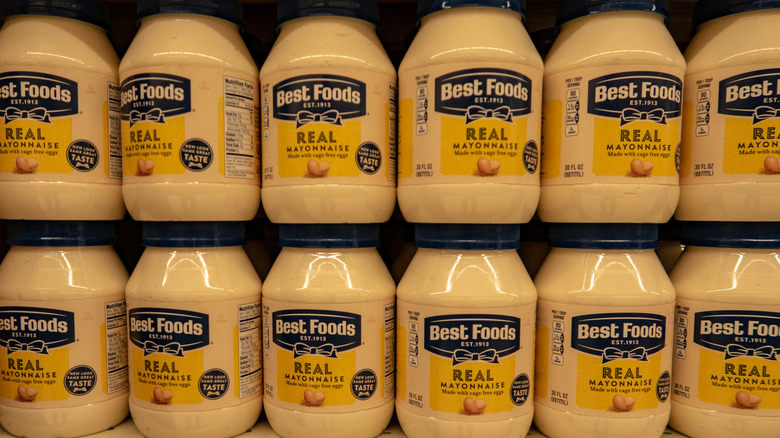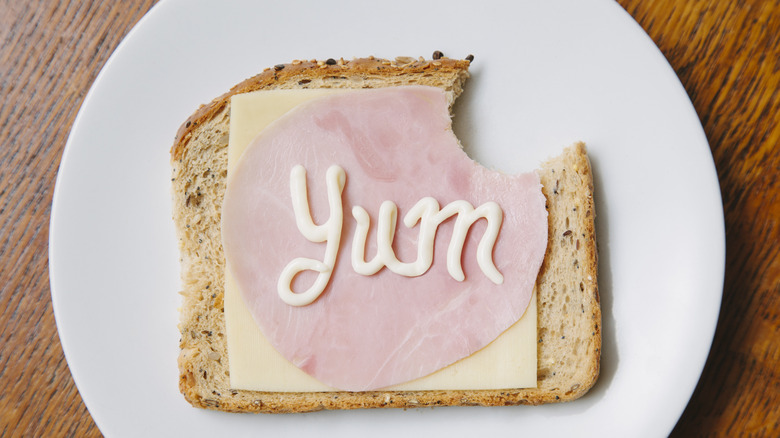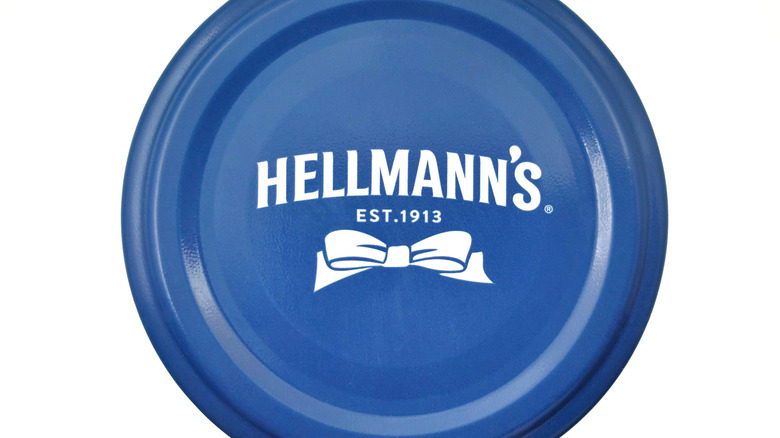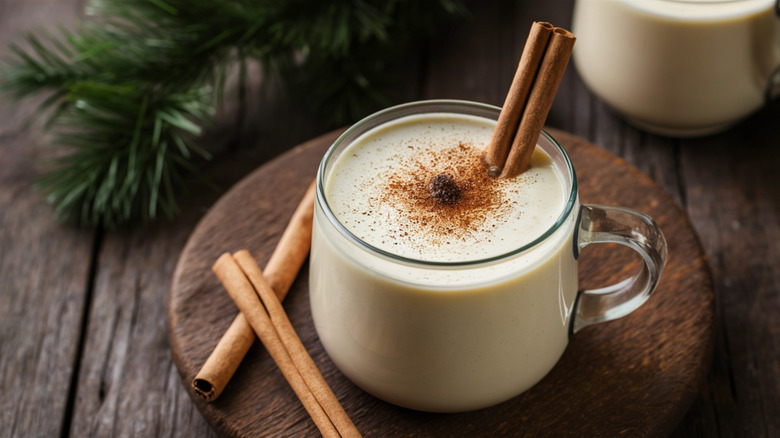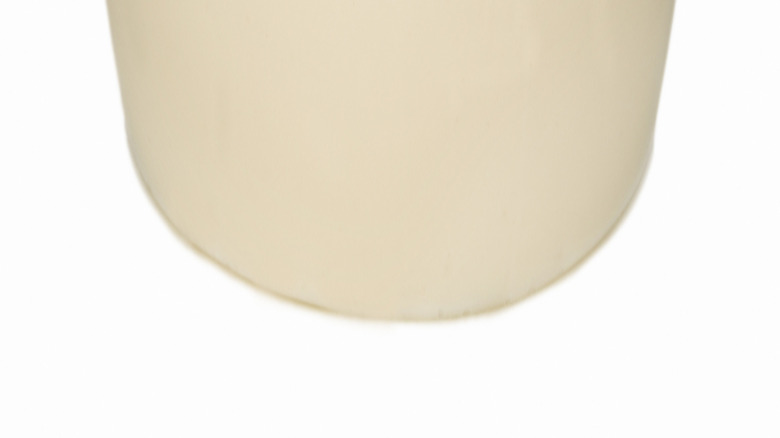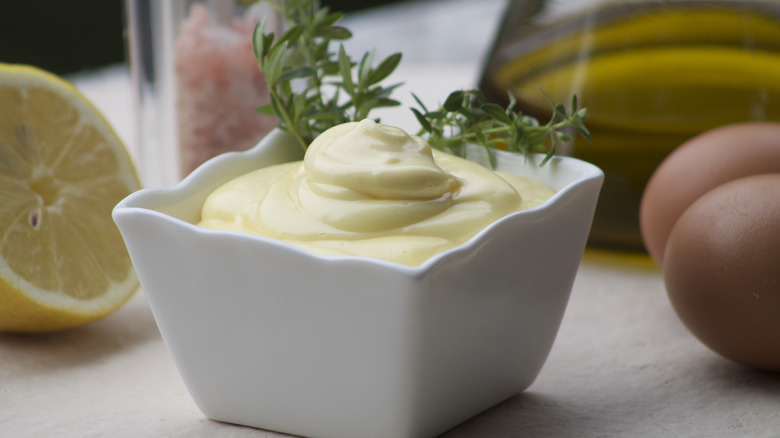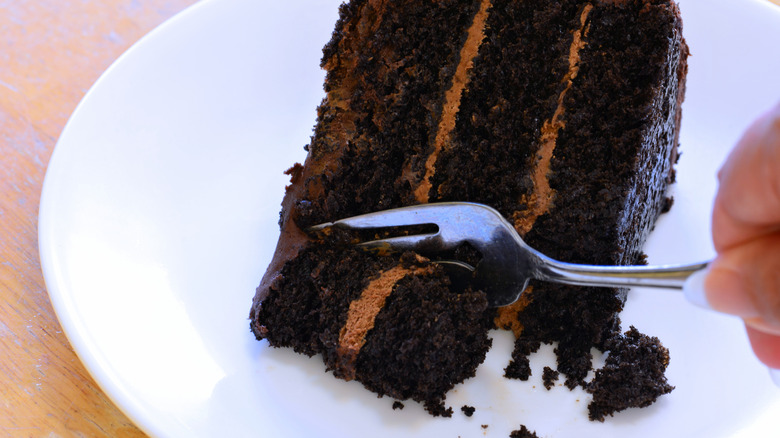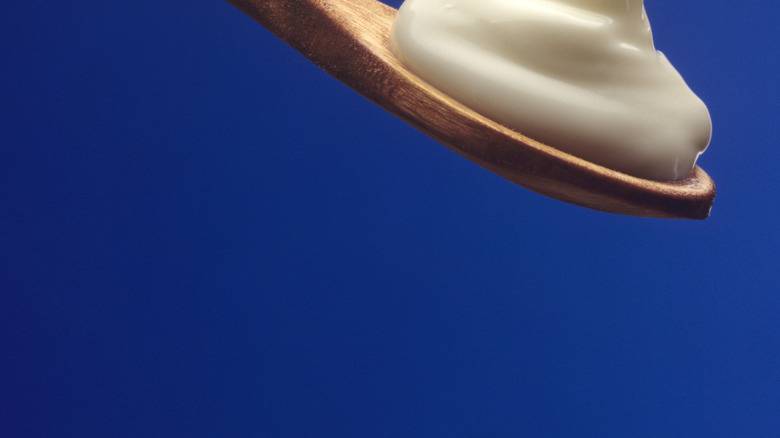11 Hellmann's Mayonnaise Facts You Didn't Know Until Now
Hellmann's mayonnaise has been a staple in American kitchens for so long it seems to be hard-wired into our everyday cuisine. Many home cooks can't imagine making an upgraded egg salad or the best tomato sandwich without it. A few brands have deeply loyal fans, such as Duke's in the South, but for legions of eaters across the country, no other mayonnaise but Hellmann's will do — any other brand would taste just wrong.
The invention of mayo was likely in France or Spain, but like many products we now consider quintessentially American, Hellmann's mayonnaise was the brainchild of German immigrant and grocer Richard Hellmann. He opened a deli in New York City, where he made his own mayonnaise for use in sandwiches and other dishes. This was not an easy thing to do well, since mayonnaise is notoriously difficult to make. Customers enjoyed his mayonnaise so much that Hellmann, recognizing a promising revenue stream, started to sell jars of it for customers to take home. A century later, Hellmann's has grown into a household name and has inspired scores of recipes — and believe it or not, even a mayo-scented perfume.
Hellmann's founder planned a trip on the Titanic
Hellmann's creator Richard Hellmann seemed uniquely positioned for success in food service. He had been an apprentice in a food hall back in Germany, and his wife had grown up in a deli-owning family. He was also gifted with good business instincts, which led him to see an opportunity in jarred mayonnaise, a previously unknown product that hungry shoppers didn't know they needed. When his mayonnaise sales started to gain traction, he went all in, ditching his deli for a distribution center and a fleet of delivery trucks.
He wasn't content with just regional or even national distribution, either. He set his sights on global mayonnaise dispersal. With international distribution in mind, Hellmann and his wife traveled to Europe in 1912 to research their options. When planning the Hellmanns' trip back to New York, travel agents proposed a tantalizing option: a trip on the maiden voyage of a brand-new, state-of-the-art luxury liner, the Titanic. Tempting as this sounded, Hellmann's priority was to get back to New York as soon as possible, so he opted for a faster voyage on a more modest ship. This decision likely saved the couple's lives.
Heard of Best Foods mayo? It's the same as Hellmann's
Hellmann's mayonnaise is such a recognizable product it makes frequent cameo appearances in TV shows and movies. While the wide-mouthed jar and its bold yellow-and-blue label will look familiar to almost all Americans, the name may not. Instead, Americans who live west of the Rockies are used to seeing another name on the label — Best Foods.
The Best Foods brand is a historical artifact. It was once another early commercial mayonnaise brand popular in the American West. In 1927, Richard Hellmann sold his business to Postum Company, which later became Best Foods. The company chose to keep Hellmann's branding in the East since it was already familiar to and respected by consumers. Thus, even close to a century later, Best Foods remains a favorite in the Western United States, while Hellmann's dominates in the other half of the country. Despite their nearly identical labels, it remains a mystery whether or not both brands use the exact same recipe, as some intrepid tasters insist they can detect a difference.
Hellmann's is a favorite among high-end chefs
Hellmann's mayonnaise has become such a dominant presence that it comprises nearly half the United States market for mayonnaise, along with its sister brand Best Foods. Perhaps because of its ubiquity, the flavor of Hellmann's defines the flavor of mayonnaise in the minds of many diners.
According to many culinary professionals, this isn't a bad thing — even high-end kitchen pros seriously respect the stuff. Every time the Boston-based chef Scott Jones makes mayo, he tells The Denver Post, "When it comes out looking like Hellmann's, I know I've done it correctly." Similarly, professional taster and consultant Joanne Seltsam considers Hellmann's to be a great example of a high-quality food product due to its perfectly balanced flavor profile. The legendary Julia Child preferred Hellman's in her American-style tuna salad instead of homemade French-style mayo.
The blue ribbon on the Hellmann's label has a special meaning
Another possible reason for Hellmann's longevity has been its ability to adapt to changing consumer tastes. For example, it offers its mayo in squeeze bottles as well as in jars. Since many of today's diners are always eager to try the next new thing, it now offers a variety of flavored versions of its classic mayonnaise, including chipotle, chile-lime, and garlic aioli.
However, the familiar plain mayonnaise in a big jar remains its flagship product. While the recipe has been slightly altered over the years, the flavor and branding have remained largely consistent. For instance, a notable feature on Hellmann's label is an image of a blue ribbon. This symbol isn't just there for looks — it hearkens back to Hellmann's earliest iteration as a deli take-out item. During the time, Richard Hellmann was still making and selling mayonnaise by himself, he offered two varieties, marking his deluxe version with a blue ribbon. The blue-ribbon variety soon became a customer favorite, and the modern Hellmann's is based on it.
Hellmann's collaborated on an eggnog recipe featuring its mayo
When you're the manufacturer of a consumable product, you want to encourage customers to use (and thus buy) as much of it as possible. For Hellmann's, this means coming up with new and creative ways to enjoy its famed mayonnaise. Nobody needs to be told how mayo can upgrade your tuna sandwich or how useful it is in a pasta salad, so Hellmann's recipe developers decided to think outside the box — way outside.
In a 2022 holiday promotion, Hellmann's collaborated with Muddling Memories, a Brooklyn-based hospitality and mixology group, to create a holiday drink no one could forget even if they wanted to: frozen mayo-nog (a boozy, slushy version of eggnog in which a generous dollop of Hellmann's mayonnaise takes the place of eggs). Rum, apple brandy, cognac, heavy cream, milk, cinnamon, nutmeg, and vanilla were also featured in the mix. Strange as it may sound, skeptical reviewers were stunned to find it was delicious. The mayo provided body while the booze, spices, and ice covered up any mayonnaise flavors. If you're curious to try this but don't care for booze, you can use bottled spiced chai instead.
Hellmann's calls its star product real mayonnaise
Cooks and eaters turn to Hellmann's not just for its flavor but for its familiarity. In a stressful, unpredictable world, it's comforting to know that longtime favorites such as Hellmann's will look and taste exactly the way you expect. The blue-and-yellow label design has undergone subtle updates over the years, but its basic design elements have remained mostly unchanged, including the puzzling words "real mayonnaise."
Careful label readers might wonder why this text is even necessary — isn't it obvious the mayonnaise in the jar is real? For the Food and Drug Administration, however, the answer isn't so simple. According to its official regulations, any product that calls itself mayonnaise must contain at least 65% oil, along with eggs. This is why you won't see the word mayonnaise on a Miracle Whip label, as it doesn't contain enough oil to qualify. So, while Hellmann's boasts that its product is indeed real mayonnaise, other manufacturers have discovered that the word "mayo" isn't regulated. This has allowed a startup to launch a creamy, egg-free spread called Just Mayo.
Hellmann's mayonnaise doesn't always need refrigeration
As summer picnic season rolls around, you may be warned to exercise caution when serving or consuming mayonnaise-heavy dishes such as potato salad or chicken salad. If left out in warm weather for extended periods, we're told, the mayo will become contaminated and trigger food poisoning. To play it safe, according to popular wisdom, any dish with mayo in it should be kept chilled during warm weather or eaten immediately after it's put out.
While potato and chicken salads can and do cause food poisoning, mayo is rarely the culprit. Rather, the low acidity of the other ingredients, along with poor kitchen or personal hygiene and warm temperatures, are the real roots of the problem. Commercially made mayonnaise, such as Hellmann's, contains enough acid to keep bugs at bay, and some varieties, including those sold in squeeze bottles, are designed to remain safe at room temperature and can even be stored outside the refrigerator.
Hellmann's tried to make mayonnaise cakes a thing
Hellmann's founder Richard Hellmann was not only a pioneer in the commercial mayonnaise business; he and his business partner also pioneered the idea of corporate cookbooks to inspire consumers to use their product. In 1922, the brand offered free copies of their first booklet, "The Chef's Standby; Blue Ribbon Recipes," with each purchase of a jar of mayonnaise.
When Hellmann sold the brand in 1927, the new owners embraced the idea of cookbooks as marketing tools. In a 1937 dessert cookbook, a recipe for Chocolate Mayonnaise Cake was shared. In the recipe, mayonnaise took the place of the usual eggs and fat, which makes sense since mayo is mostly eggs and oil itself. With the Great Depression on the horizon and the rationing of dairy ingredients that followed, the mayonnaise cake gave cooks a practical and accessible way to treat themselves and others. For modern cooks, it has the benefit of being appealingly moist and fast to make. Don't worry, you can't taste the mayonnaise.
Dale Earnhardt's favorite sandwich features bananas and Hellmann's
When most of us think of uses for mayonnaise, the first things that come to mind are sandwiches. No Thanksgiving leftover turkey sandwich would be complete without a generous smear of mayo, and of course, mayo plays a starring role in favorite sandwich fillings such as egg salad, tuna salad, and for Southerners, snappy pimiento cheese — a savory spread of grated cheddar cheese and chopped pimientos bound with mayo.
Like many sandwich lovers, racing legend Dale Earnhardt, Jr. considers Hellmann's to be his mayonnaise of choice. His favorite filling, however, may baffle some of his fans. He loves sliced bananas layered between slices of white bread slathered with Hellmann's. Believe it or not, he's not the only one; the weird but humble sandwich is a favorite in the American South, where its filling and affordable ingredients made it a practical choice during the Great Depression. As a product of the South himself (Earnhardt was born in North Carolina), his taste in sandwiches reflects his pride in his roots.
Hellmann's suggested adding mayo to coffee, sparking online outrage
Since its founding, Hellmann's has built a devoted base of fans, from Katie Couric to Drew Barrymore. However, the brand has not been content to rest on its laurels and continues to devise novel ways to promote its flagship product. While some of its promotional ideas (such as mayo-based eggnog and chocolate cake) have raised eyebrows, few have engendered serious backlash — until the brand proposed adding mayonnaise to coffee on the social media site Twitter (now known as X).
To be fair, people have been adding creamy ingredients to coffee for centuries. A favorite sweet treat in Vietnam is egg coffee, in which a cup of dark coffee comes with a foamy, custardy topping of whipped egg yolks and condensed milk. Perhaps Hellmann's was shooting to create a shortcut version of this classic, but even its staunchest loyalists weren't having it. One fan replied to the company's post, "I love you intensely, Hellmann's, but this tweet is pure violence" (via the Mirror). Singer Dionne Warwick was so repulsed by the idea she blocked Hellmann's account.
Hellmann's now has a vegan version of its mayo
While Hellmann's original mayonnaise continues to be the spread of choice for many cooks and eaters who appreciate its balanced flavor and richness, a growing number of consumers have turned away from meat and dairy. Between 2014 and 2018, Americans embracing vegan diets increased by 600%, and vegans cite a range of reasons for their choice. For some, health and a desire for weight loss were deciding factors, while others were motivated by concerns for animal welfare or the environment.
Hellmann's egg-rich flagship product is an obvious no-go for vegans, so in 2016, the company introduced its Plant-Based Dressing and Spread. While there are many ways to make vegan mayo, the brand's main ingredients are canola oil, water, starch, and distilled vinegar. Because it doesn't contain eggs, it can't legally be called mayonnaise, but Hellmann's website recommends it as a sandwich spread and condiment for veggie burgers, so it's clearly meant to fill the same dietary niche as real mayonnaise.
